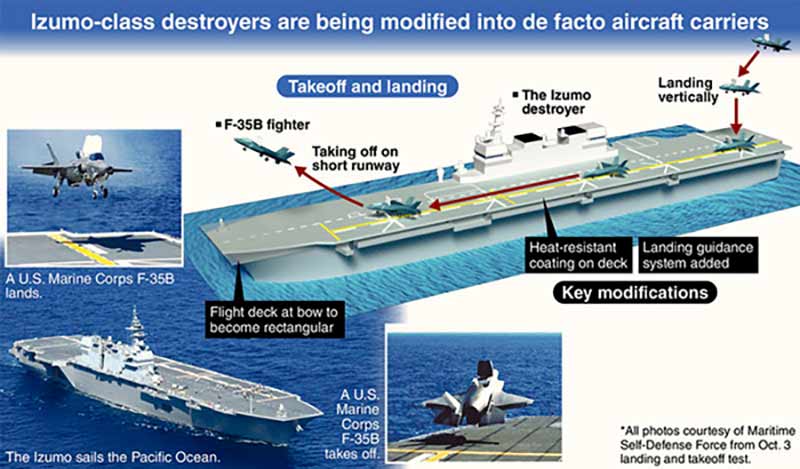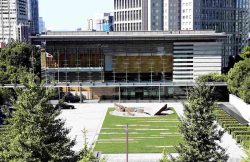
November 25, 2021
The Maritime Self-Defense Force has been modifying two of its Izumo-class destroyers, the Izumo and the Kaga, into de facto aircraft carriers, the first in the history of the Self-Defense Forces. The government plans to deploy them sometime after April 2024, but why does Japan need to possess them and how will they be used?
On Oct. 3 in the Pacific Ocean off Shikoku, two F-35B fighter jets belonging to the U.S. Marine Corps stationed in Japan took part in a test to land on and take off from the Izumo destroyer, which had completed the first stage of its modification. As the F-35Bs slowly and successfully landed vertically on the deck, the U.S. and Japanese personnel aboard the vessel applauded.
For many Japanese, the prototypical image of an aircraft carrier may be the U.S.S. Ronald Reagan based at the U.S. naval installation in Yokosuka, Kanagawa Prefecture.
The Nimitz-class U.S. aircraft carrier is about 333 meters long and can carry more than 60 aircraft, including fighters. Airplanes are launched from the carrier with great force using catapults. Such large aircraft carriers are also called “mobile air bases” that form the core of modern navies.
Izumo-class vessels, on the other hand, are 248 meters long, relatively small for an aircraft carrier. It is expected that the modified vessels will carry about 10 fighters.
Plan to carry F-35Bs
The Izumo was launched in 2015 and the Kaga followed in 2017. Unlike conventional destroyers equipped with guns and missile launchers, the Izumo and Kaga have full-length flight decks, flat from bow to stern, allowing them to carry a large number of helicopters.
This design makes them look the same as aircraft carriers, leading them to be dubbed “helicopter carriers” as well.
Their mission has been to monitor other nations’ submarines by deploying onboard helicopters and to transport a large quantity of supplies loaded in their large bodies. During disaster relief operations in the aftermath of the Kumamoto Earthquake in 2016, they transported SDF personnel and about 40 vehicles from Hokkaido to Kyushu.
Because of their length, it is difficult for conventional fighters to land or take off. For this reason, they will carry state-of-the-art F-35Bs, which can take off on short runways and land vertically by swiveling the engine exhaust nozzle down.
In the first stage of each vessel’s modification, a heat-resistant coating has been applied to the deck to withstand the extreme heat from the exhaust of the F-35Bs. In the second stage, the narrow part of the flight deck at the bow will be changed into a rectangular shape to reduce the effects of turbulence from below.
China threat, remote islands
By possessing de facto aircraft carriers, the government wants to strengthen the air defense over possessions in the Pacific Ocean and the Nansei Islands, the island chain between Kyushu and Taiwan. While the government has not named any specific entity, the intention is to prepare for the threat from China.
The Chinese military currently has two aircraft carriers. In recent years, the nation has been frequently deploying a fleet from the vicinity of the Nansei Islands heading out to the vast Pacific Ocean. In addition, China claims ownership of the Senkaku Islands in Ishigaki, Okinawa Prefecture, and has been increasing pressure on Japan by having armed coast guard vessels repeatedly enter Japanese territorial waters.
Japan only has one runway over 2,400 meters long used by SDF fighters in the vast Pacific Ocean, on Iwoto island, and only one on the Nansei Islands at Naha Air Base on Okinawa Island. The distance from the Naha base to the Senkaku Islands and Yonaguni, the westernmost island of the Nansei chain, is 400-500 kilometers.
If the Nansei chain or other remote islands encounter an attack by the Chinese military, the SDF’s aircraft, which need to fly to and from Kyushu or Naha Air Base, would be at a disadvantage, as China could have its planes fly from an aircraft carrier.
Once the Izumo-class vessels’ conversion into aircraft carriers is complete, fighters will be able to use them as a base to engage in the defense of remote islands. They will also be useful for warning and surveillance activities in the Pacific Ocean in times of peace.
Of course, the Japanese government’s primary goal is to prevent armed attacks by other nations. The government is trying hard to strengthen its deterrence to discourage countries from attacking Japan by enhancing its defense capabilities through such measures as modifying the Izumo-class vessels into carriers, while making diplomatic efforts to avoid a deterioration in its relations with nations such as China.
Within scope of SDF
Aircraft carriers came on the scene in the beginning of the 20th century. Since the end of World War II, they have replaced battleships as the main capital ship of navies. The former Japanese military had large-scale aircraft carrier groups. In the Japanese forces’ attack on Pearl Harbor in 1941, six aircraft carriers launched 350 aircraft to take the U.S. Pacific fleet in Hawaii by surprise.
After the war, the current Constitution was written. In Article 9, it stipulates that “war potential” will never be maintained. Japan is allowed to have only the minimum necessary self-defense capabilities. In particular, the government has taken the position that it cannot possess “offensive weapons” that are used “only for the catastrophic destruction of the territory of other countries,” and has given as an example “offensive-type aircraft carriers.”
This idea indicates that an aircraft carrier that is always equipped with a large number of aircraft with strong capabilities to attack land is construed as “war potential” that goes beyond the force needed for self-defense.
Nevertheless, the government has always expressed its position that having aircraft carriers used only for defensive purposes is within the scope of self-defense capabilities and is not prohibited by the Constitution.
The government has also explained that the modified Izumo-class aircraft carriers are not classified as “offensive-type aircraft carriers” because they are used only to make counterattacks against aircraft and ships of enemies that invade Japan. They will remain classified as destroyers. The F-35Bs will normally be at an air base and carried onboard when necessary, in the event of an emergency or for warning and surveillance activities.
"Politics" POPULAR ARTICLE
-

Japan to Support Central Asian Logistics Route That Bypasses Russia, Plan to Be Part of Upcoming Summit in Tokyo
-

Japan to Tighten Screening of Foreigners’ Residential Status by Providing Information of Nonpayment of Taxes
-

Takaichi Cabinet Approval Holds at 72% as Voters Back Aggressive Fiscal Stimulus, Child Benefits
-

Chinese, Russian Bombers Flew Unusual Path by Heading Toward Tokyo; Move Likely Meant to Intimidate Japan
-

Takaichi Meets Many World Leaders at G20 Debut in Johannesburg; Speaks with Heads of Countries Including Italy, U.K., Germany, India
JN ACCESS RANKING
-

Keidanren Chairman Yoshinobu Tsutsui Visits Kashiwazaki-Kariwa Nuclear Power Plant; Inspects New Emergency Safety System
-

Imports of Rare Earths from China Facing Delays, May Be Caused by Deterioration of Japan-China Relations
-

University of Tokyo Professor Discusses Japanese Economic Security in Interview Ahead of Forum
-

Japan Pulls out of Vietnam Nuclear Project, Complicating Hanoi’s Power Plans
-

Govt Aims to Expand NISA Program Lineup, Abolish Age Restriction
























